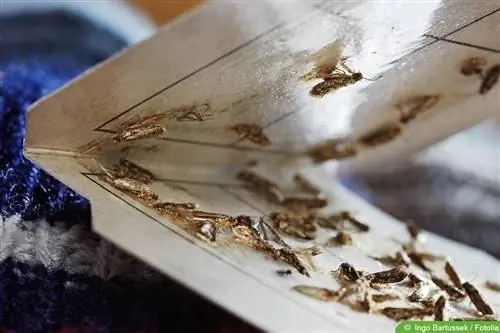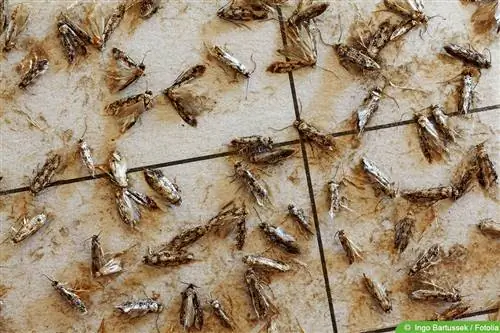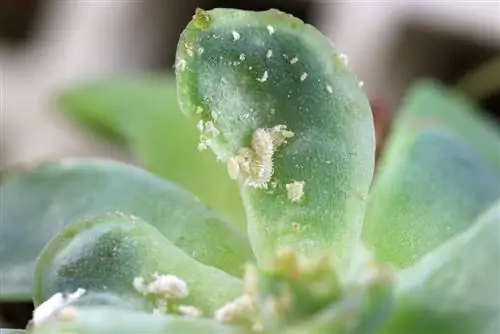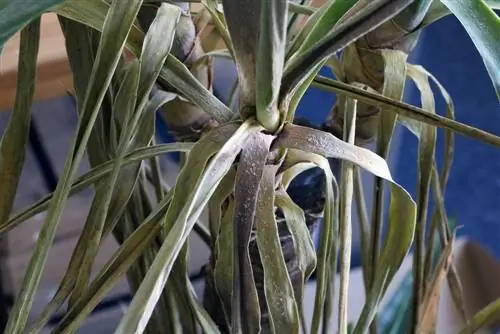- Author admin [email protected].
- Public 2023-12-17 03:39.
- Last modified 2025-01-24 12:45.
Clothes moths can cause significant damage. It is therefore important to recognize and combat them as early as possible. But how does it work? Find out simple solutions here.
Identifying clothes moths
The easiest way to detect an infestation with clothes moths or their larvae is to check your clothing regularly. Natural materials of animal origin in particular attract pests.
These include, for example:
- Down and feathers
- Skins
- Leather
- Fur
- Silk
- Wool
Clothing and shoes but also home textiles and books can be affected. Moth damage is characterized by small, round or irregular holes in the material. These arise because the larvae feed on the keratin they contain. A visual inspection is therefore sufficient to detect an infestation. Adult clothes moths can also be noticeable if, for example, they fly to a light source or are startled when opening a cupboard.
Eggs and larvae
Identifying the eggs and larvae is more difficult but important for combating the moths in the long term. Because it is not the adult insects that cause the damage. They just create the nest and lay the eggs. In addition, they do not eat any more food after development is complete. Their lifespan after the larval stage is only about 18 days. A nest of 200 to 250 eggs is preferably placed in an area that meets the following criteria:
- dark
- dry
- undisturbed
- warm
These include, for example:
- Spine
- Cracking upholstered furniture
- Cabinets
- Carpets
- Chests
- folded blankets or fabrics
The real culprits are the moth larvae, which hatch from the eggs in the nest after about two weeks at room temperature. Due to their small size and inconspicuous, light yellowish-brown color, they are difficult to recognize. However, white, thin threads that resemble spider webs are a clear indication of an infestation. They are called moth webs.

Control
In order for the infestation to be detected, a very thorough approach is required. The following tips may help:
Examine individually
Checking all items of clothing individually is important in order to find the small clutches and possibly moth webs or even larvae. Inside pages, folds and folded pieces are common locations.
Search in niches
Cracks in upholstered furniture, rolled-up carpets and books that are rarely opened are popular places, as is the back corner of the closet.
Use pheromone traps
The adult butterflies can be caught with special pheromone traps for these moths. Although egg laying cannot be avoided in every case, infestation with the six to ten millimeter large insects can be determined with certainty. This variant is particularly recommended if regular checks at short intervals are not possible.
Check regularly
Due to the rapid and numerous reproduction, everything should be checked as often as possible. This is especially true if an infestation has already occurred.
Fighting parasitic wasps
A particularly simple way to combat clothes moths is to use parasitic wasps or their moth larvae. They attack the harmful insects and feed on them.
The advantages are:
- the animals die as soon as there is no longer a food source available
- easy to use
- low cost
- Easily available in stores and can be ordered online
- Parasitic wasps do not pose a danger to other living creatures or textiles
- little effort
After the fight, thorough cleaning should be carried out again. This applies to both the textiles and the containers in which they are stored and the surrounding area.
Vacuum cleaners, disinfectants and hygienic cleaners, for example, are well suited for this. The contents of the vacuum cleaner bag or dust container should be disposed of immediately. Otherwise the moths could spread again.
Prevention
As always with moths, prevention is better than cure or in this case control. On the one hand, odorants and, on the other hand, appropriate storage are crucial. Thorough cleaning and good organization are also useful.
Odorants for prevention
Scents are repellent for moths in both prevention and control.
Lavender
Dried lavender in scented sachets or the essential oil of the plant dripped onto cloths can be put in the closet with the laundry.
Mothballs
These balls are hung in the wardrobe or placed between layers of textiles and repel insects. However, people often find the smell unpleasant.
Cedarwood
Card hangers, discs, balls and shavings made of cedar wood not only spread a pleasant scent, but also efficiently repel moths.
Tip:
There are also products on the market that are odorless for humans, such as Aeroxon moth repellent. These are laid out or hung in vulnerable areas and quickly become effective.

Adapted storage
If clothing, shoes or other textiles are not needed for a long time, it makes sense to store them accordingly. For example, bags or bags in which a vacuum can be created are cheap. This works, among other things, with:
- Special foil and a vacuum sealer
- Plastic bags from which the air can be rolled or squeezed out
- through special bags with a vacuum cleaner
Tip:
Alternatively, boxes and chests that are as airtight as possible can be used to protect materials of animal origin in particular.
Cleaning and ordering
Moths that target keratin and thus shoes, clothing and other materials prefer undisturbed areas. Regular cleaning breaks this peace and may even remove an existing nest in the corner of the cupboard or on the carpet.
Cleaning is easier when there is order and basic cleanliness. Textiles - especially those of animal origin - should be washed or dry cleaned before storage. This removes hair and skin cells and also changes the smell. This means there is less attraction for the moths.
Order stacks also allow you to quickly check the cupboard and wipe it out if necessary.






